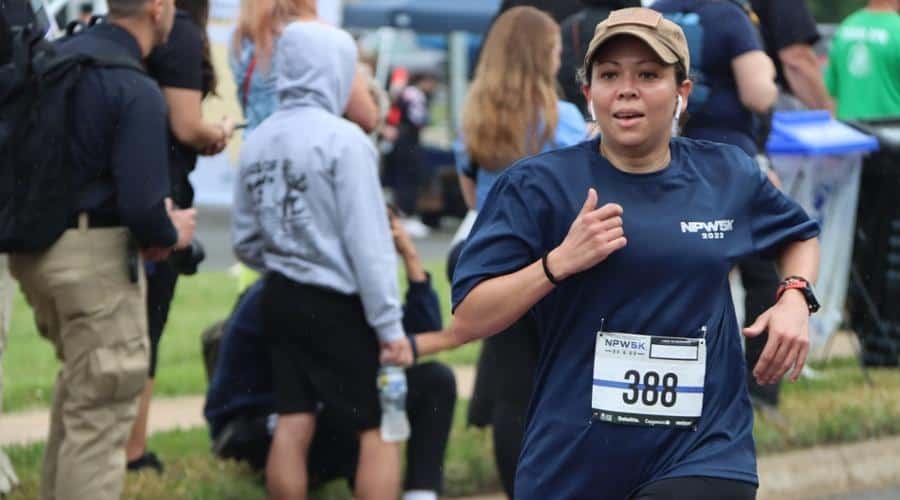As you prepare for the application and selection process for the William D. Clarke, Sr. Diplomatic Security Fellowship, make sure you build in time to prepare for the Physical Readiness Test (PRT).
If you are selected as a finalist, you’ll have the opportunity to take the actual PRT, proctored by the Diplomatic Security Service (DSS), as a baseline. This is the same PRT that active DSS Special Agents in the field take.
While your PRT test results will not be used as part of the selection process, taking the PRT as a finalist not only gives you a valuable experience, but also provides you with your actual scores. This is a great opportunity to see how you perform on the PRT standards today and to know what areas you’ll want to focus your training for your future pre-employment PRT.
As you successfully complete the two-year fellowship program and the Foreign Service entry requirements, you’ll be required to pass the PRT to become a Diplomatic Security Service (DSS) Special Agent.
So, grab a buddy and a stopwatch, and start training now. If you start now and practice consistently, you will be able to pass the test. Keep reading to find out what’s in the PRT, how to properly do the exercises, and what to avoid doing to ensure your success.
Why is the PRT important?
As a Clarke DS Fellow, you must be prepared to enter the Foreign Service as a DSS Special Agent at the end of your fellowship program. Physical readiness is crucial to your role as a DSS Special Agent. As federal law enforcement officers, DSS Special Agents must perform duties in the field that are physically and mentally demanding. They must be willing and able to meet these physical demands in high-stress, high threat environments.
Keep in mind that this information about the PRT should serve as a guide to help you prepare. DSS may make changes to the PRT in the future.
What does the test consist of?
The PRT tests your muscular endurance and aerobic capacity. You’ll do three “events” in sequence, with a rest period between each event. The rest period may be a minimum of five minutes or a maximum of 30 minutes.
- First event: Maximum push-ups completed to standard in two minutes
- Second event: Maximum sit-ups completed to standard in two minutes
- Third event: 1.5-mile timed run
It’s Not Just Any Push-up or Sit-up
The push-ups and sit-ups must be performed properly, keeping the strict form outlined below – or the test will terminate early. Watch this video to see the proper form demonstrated: Diplomatic Security Physical Readiness Test Video.
Two-Minute Push-ups
- Begin in the “front-leaning rest” position, with palms or fists placed on the floor directly beneath or only slightly wider than your shoulders. Keep both feet together on floor.
- Keep your neck, back, buttocks, and legs straight from head to heels throughout test. Your toes and palms/fists must remain in contact with floor.
- Feet must not be in contact with a wall or other vertical support surface unless the test is being performed in the mat room of the Interim Training Facility (ITF).
- At the command of “Go,” lower your entire body as a single unit by bending the elbows until the chest or chin makes contact with the Proctor’s fist. (Male participants will touch chest to fist. Female participants will touch chin to fist.) The minimum height of the Proctor’s fist shall be no less than three inches.
- Immediately upon making contact with the Proctor’s fist, return to the starting position by extending your elbows and raising your body as a single unit until the arms are fully extended at lock-out.
- One repetition will be counted each time the arms are fully extended after touching the Proctor’s fist.
- Once the test has begun, you may rest only in the front-leaning rest position with arms extended. You will maintain arms, neck, back, buttocks, and legs in a straight position. You may briefly move into an arch/downward dog position to stretch, but you must return completely to the front-leaning rest position before resuming movement.
- Repeat the push-ups correctly as many times as possible in two minutes.
Termination of Push-Up Test
If you are doing the push-ups properly, the test is complete after the passage of two minutes. Otherwise, the test will terminate early if you:
- Touch the floor/ground with any part of the body other than the hands and feet;
- Raise one or both hands or feet off the floor/ground;
- Rotate the body to the left or right.
If your push-up test is terminated before two minutes have elapsed, the number of push-ups that you properly performed will be recorded for your score.
Two-Minute Sit-ups
- Start by lying flat on your back with knees bent and feet flat on the floor/ground. Position your heels so that the knees are bent 90 degrees. The buttocks will remain in contact with the floor/ground at all times during the test.
- Fold your arms across your chest, with arms touching each other and the bottom arm in contact with the chest; your hands touching the upper chest or shoulders.
- At the command of “Go,” curl your body up and touch your elbows to the bottom of the thighs. You must keep your hands in contact with your chest, shoulders, or upper arms at all times.
- After touching the elbows to the bottom of the thighs, lie back to touch the small of the back to the floor/ground. You may touch your shoulders to the floor/ground without penalty.
- One repetition shall be counted each time you touch the thighs after making contact with the floor/ground with the lower back.
- You may rest in the down position with your back on the floor/ground. There is no time limit on the length of your rest, other than the time limit of the test itself. But keep in mind that you are scored on the number of properly performed sit-ups in two minutes.
- Repeat the sit-ups correctly as many times as possible in two minutes.
Termination of Sit-Up Test
If you are doing the sit-ups properly, the test is complete after the passage of two minutes. Otherwise, the test will terminate early if you:
- Lower your legs;
- Raise your feet off the ground or floor.
If your sit-up test is terminated before two minutes have elapsed, the number of sit-ups that you properly performed will be recorded for your score.
Timed 1.5-Mile Run
The final event is a 1.5-mile run conducted on a track or outdoor course.
- Participants shall stand at the designated start line.
- At the command of “Go,” participants shall begin running. Participants will complete the 1.5-mile course.
How Are You Scored?
Your PRT score will be based on the number of push-ups completed in two minutes, the number of sit-ups completed in two minutes, and the time taken to complete the 1.5-mile run. The scoring takes into account your age and gender, as well as the test site elevation (less than or greater than 5,000 feet above sea level).
Click this link to see a table of the age/gender standards to get an idea of what your goal should be for each part of the test.
You’ve Got This
When you start practicing the sit-ups and push-ups, don’t be discouraged if you have difficulty keeping the correct form at first. Do as many sit-ups and push-ups correctly as you can – even if it is only one or two – and try to increase that number each day. And don’t forget to start jogging regularly to train for the timed 1.5-mile run. With regular and consistent practice, you will be able to pass the PRT. We know you can do it!







